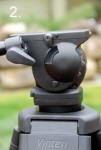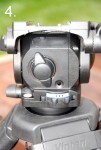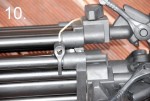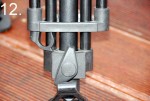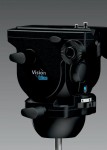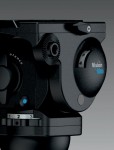Vinten Vision Blue
Video Pan/ Tilt Head and Tripod System
Reviewed By Chris Soucy
Background
Soon after receiving the pre production Vinten Vision 3 AS to review last year, it became apparent that the counterbalance system of the 3 AS simply wasn’t going to play nice with my Canon XH A1 in “straight out of the box” mode. Luckily for me, my standard rig included a substantial shotgun microphone and wireless receiver, so I could, at least, get the unit to counterbalance at the heads minimum setting, thus making the entire review process viable.
I think it fair to say I left Vinten in no doubt that I felt this was an opportunity lost, both to themselves and to many, many shooters with similar (or even smaller) size, weight and cost cameras to my own, and that they really needed to address the issue at a price amateurs and semi professional shooters would or could be prepared to pay. To cut a long story short, Peter Harman, Product Manager for Vinten, agreed (who say’s companies don’t listen?) and he and his team set about making it happen..
Vision Blue is the result, and what a pleasantly surprising package it is.
Now, before I go any further, a bit of background about why I’m so blown away with Vision Blue. Some of you will be aware that my standard support system consists of a set of Vinten FiberTec sticks (second only to a block of reinforced concrete as a base), Vision 3 AS head, Spreadlock spreader and Vinten padded rigid case. List price for everything, somewhere in excess of $4,000 US. When Peter mailed me the proposed price for the new systems, it gave me serious pause for thought.
Right from the beginning, Vision Blue threw up some pretty major conundrums. On the one hand, the spec was for a system priced for amateurs and semi pro’s, which the proposed price most surely is. On the other hand, the spec was, to use a motoring analogy, like asking Rolls Royce to make a Mini at a Mini price but with all the quality and performance of a Rolls Royce. I just could not see how Vinten were going to square that circle without taking some serious liberties with something. Surely it couldn’t be done without cutting corners somewhere?
So it was with an air of mild foreboding that I embarked on my investigation of the Vision Blue system.
I can truthfully say that from the moment I opened the shipping box, Vision Blue has done nothing but hit me with one (pleasant) surprise after another as it rapidly proved to be the second most amazing camera support system I have ever used (and far and away the best twin tube tripod system by a country mile), and when you’re second only to a system costing more than 3 times the price, that’s saying something indeed.
Now, those of you doing the math will have figured out that in order to put together such an amazing system at the price, something has had to give, and I think ergonomics probably sums it up. Whilst the quality and performance of this system are at Vintens usual standard of excellence, there are a few areas where it’s a tad clunkier than my existing system, which I have used as the benchmark for this review.
I’ll leave it to you whether you think “clunkier” is worth the nearly $3,000 difference in the two systems. OK, on to the review. Oh, the list of cameras targeted by Vision Blue is tacked on to the end of the review.
Vinten Vision Blue
The initial release of Vision Blue will be two systems, both based on Vintens standard Aluminium 2 stage 75 mm tripod (3819 – 3), a Vision Blue head, Rounded Case (3358 – 3) and either floor level (VB – AP2F) or mid level (VB – AP2M) spreaders. Both systems should be available by the end of September at a recommended price of US$1,375, though street prices may well be significantly lower.
Late breaking news: The Vision Blue head will be available separately for a recommended price of $850 or thereabouts.
The system comes with a two-year comprehensive warranty when registered with Vinten on – line at: www.vinten.com
 System Components
System Components
1. Vision Blue Head
The Vision Blue head is a re–sprung and re-liveried Vinten Vision 6 head, the next model up from the original Vision 3, but unlike the V 3, has infinitely variable counterbalance built in. Sadly, the very useful side load head plate of the AS series has not made the cut.
The counterbalance design specification for Vision Blue is for a 2.1 kg to 5.0 kg payload at a COG of 55 mm (down from the usual 125 mm quoted for most other heads). At the top of its range, it just overlaps the bottom counterbalance range of the Vision 3 AS.
The layout of the head is standard Vinten, slot load head plate, with safety release on the left (looking from the operating position), plate lock lever on the right, forward of and almost completely obscured by the rosette and pan bar.
As you can see from these two photos, the production model livery is very smart (Vision blue 1 & 2).[Photos courtesy Vinten]
 LHS of the head has both the pan and tilt locks (photo 1.); RHS, the tilt drag dial (grey in the production model), vertical, facing forward (photo 2.); front face, the Vinten badge (photo 3); rear face the pan drag dial set low and horizontal (also grey in the production model), bubble illumination button (blue on production model) above it and the variable counter balance knob more or less left central. The bubble illumination battery is under a removable plastic flap, top centre. The illumination LED will be blue (photo 4.).
LHS of the head has both the pan and tilt locks (photo 1.); RHS, the tilt drag dial (grey in the production model), vertical, facing forward (photo 2.); front face, the Vinten badge (photo 3); rear face the pan drag dial set low and horizontal (also grey in the production model), bubble illumination button (blue on production model) above it and the variable counter balance knob more or less left central. The bubble illumination battery is under a removable plastic flap, top centre. The illumination LED will be blue (photo 4.).
With the slide plate detached, the head, pan bar and clamp knob weighs in at about 2.7 kg or a whisker less than 6 pounds. The finish, as you can see, is black. Speaking of the slide plate, it’s one of the new designs, allowing the captive ¼” screw and VHS pin to travel almost the full length of the plate, thus giving much better balance options on front/ rear heavy rigs.
In use, it is an instant déjà vu of my Vision 3. Spoiled rotten with the side load of the 3 AS, the return to the slot load is a bit of a shock, as it’s a bit fiddly, with the front of the plate hidden under the base of the camera, so I’m having to re – learn it’s loading all over again.
It hasn’t happened to me yet, but I’m convinced the head lock lever, situated forward of the pan bar rosette will, as on my V 3, develop a mind of its own and self lock whilst in transit (or even when your back is turned!), thus preventing the slide plate from loading, requiring frantic fiddling to find the (almost invisible) lever whilst holding the camera and plate in a quarter loaded position. Ah, memories are made of this!
The counterbalance knob has a fairly easy 5 1/4 turns from full off to full on. My Canon XH A1 in “out of the box” mode counterbalances a treat at any setting from zero turns to 1 ½ turns, my XL1s at 2 ½ turns, my pimped A1 at 2 ¾ turns. There is a “gotcha” with the counterbalance engineering of both the Vision Blue and AS series BTW, which I missed entirely with my review of the 3 AS, owing to having no way to test the counterbalance at anything but zero.
Owing to the “compressed spring” design, the greater the compression applied, the shorter the spring gets. The shorter it gets, the less the head will tilt before the spring is compressed completely and it stops dead. My figures, which I understand are similar to Vintens’ own, are 0 to 1 ¼ turns = 90 degrees, 2 turns = 78 degrees, 3 turns = 64 degrees, 4 turns = 50 degrees, 5 turns = 30 degrees, 5 ¼ turns = 27 degrees. This implies that my pimped A1 must have a tilt limit of about 67 degrees, which in practice didn’t become an issue at any time. If your rig is, or is likely to be, up at the top end of the Vision Blue counterbalance range, it may be worth loading it up even more and going for a Vision 3 AS instead (photo’s 5 & 6, max. and min tilt).
The performance of the head is flawless. The usual Vinten silky smooth pan and tilt starts and stops, superb constant velocity movement in any axis and not a hint of pullback at pan ends. In short, as perfect as I can ever imagine any head being. The infinitely variable drag controls are still a tad on the tight side to turn at the upper ranges, though some of that will work itself out with use, but the drag itself is, again, as smooth as silk.
To be honest, if it had been any different, I would have been most surprised.
2. Vinten Tripod, Spreader and Boots
Tripod (3819 – 3)
The two-stage tripod is something of a revelation. This is a standard Vinten unit, not some downward-engineered item to keep the price down. It’s solid, well made and exceedingly rigid, not up there with the FiberTec’s “concrete block” performance but more than adequate for any HD camcorder likely to be mounted on them.
Part of this difference can be explained by the fact that it’s a 75 mm unit as opposed to my FiberTecs 100 mm, the rest due to its parallel twin tube design. The bottom, single tube stage is actually an oval cross section, further aiding in its rigidity (photo 7.).
In it’s boots and with the spreader fitted, the tripod weighs in at 4 kilos dead, about 8 ¾ pounds. The entire system – head, tripod, spreader, boots and bag, weigh in at 8 kilos dead, about 17.6 pounds.
The underside of the receiver is fitted with the usual Vinten hook for hanging steadying weights if required (photo 8.)
In use, the tripod has a very substantial feel to it. The leg locks are very positive, snapping shut with a confidence inspiring “thunk”, but require a fair amount of finger pressure to operate, though I assume these will ease up with use. The hinge pins and bearing on the leg/ receiver joint are extremely tight, without a hint of play, yet not so tight they impede easy leg spreading. Interestingly, although I can detect some (entirely expected) movement in the top of the bottom single stage leg between the twin tubes of the centre stage when partially retracted, this movement doesn’t seem to filter through to the tripods performance in any way.
The unit is exceedingly rigid at all set heights and, again, surprisingly, seems to be immune to wind up, no matter how hard I provoked it. This is excellent performance from a twin tube design and certainly way in excess of my expectations.
There are some issues, however, one more “down the track” than immediate, and all of them fall into the annoyance category rather than problems. It might seem I have been overly harsh with the following comments, but the Vision Blue sticks were, perhaps unfairly, up against my Vinten FiberTecs, and every point is one where the test sticks diverge from the FiberTec’ superb layout, ergonomics and handling.
More on the FiberTecs’ here:
https://www.dvinfo.net/article/production/camsupport/review-vinten-fibertec-video-tripod-system.html
OK, here we go:
Firstly, the leg lock for the bottom stage is situated at the bottom of the middle stage, which means, in practice, that with the closed tripod feet resting on the ground, that’s where you have to bend to undo them. Those challenged in the lower back department, as am I, will find this a pain, literally. (photo 7.)
Second, if the boots (that are supplied) are fitted to the bottom stage, the attachment thong sits directly over the lower leg lock knob, making access difficult. In practice I would leave the boots off and save myself the aggravation. From memory, in all the time I’ve had my FiberTecs, I’ve only ever used the boots once (photo 9.).
Also, the leg lock strap, which is actually a thin, circular cross section bungy cord with a black plastic hook attached to the end, that pulls out of the bottom of one of the centre stage tubes, really doesn’t look man enough for the job long term. I may be wrong, time will tell (photo 10.).
Another issue with it is that when retracted, it’s easy for the hook to swivel around and come to rest between the extended mid stage bottom brace and the bottom of the top stage, preventing that leg from being completely retracted (photo’s 11 & 12).
And finally the clamp knob. I have commented in the past about the chunky Vinten 3 lobed clamp knob having issues with some other manufacturers tripods. Never would I have dreamt it could do the same with a Vinten unit, but indeed, it does with this one.
Point one is where the leg lock strap hook, has, indeed, wedged itself between the two stages, thus preventing the leg from fully retracting. Attempting to close the legs together for transit in this state can cause the mid section, top brace of the affected leg to collide with a lobe on the clamp knob. I haven’t noticed it doing any damage, it simply throws the head out of alignment by pushing the clamp knob over. With familiarity I think you’d simply add “check the legs are fully retracted” to the knockdown checklist.
Point two. The cause of this one took a bit of sleuthing. With my FiberTecs, I simply grab the rear of the head plate in one hand, flip the leg lock levers with the other hand, lift the tripod to the required height, lock the levers, THEN spread the legs.
Attempting the same manoeuvre with this unit more often than not resulted in one leg (or more, I’ve had all three locked up) simply refusing to drop, “something” having collided with “something” else. It took a while to figure out that the top brace(s) of the centre stage was actually sitting on a knob lobe, preventing the leg from dropping, until the legs had been spread enough to clear it (photo 13.) In case this isn’t self explanatory, photo 13 shows a leg mid section top brace firmly wedged behind a clamp knob lobe [centre, top] with another about to do the same thing as the legs are closed [centre, right].
Of course, having to spread the legs before they drop means that locking the bottom locks subsequently requires more serious contortions.
Annoying? Yes, but given enough familiarity, quite workable and maybe I’ve just got into bad habits.
Mid Level Spreader (V4032-0001)
The mid level spreader supplied with the VB – AP2M is borrowed from the ProTouch range. It doesn’t have the press button arm extender control of the Spreadlock spreader nor the extender arm breakaway safety device, relying instead on twist knobs on each arm, However, in it’s favour, it hasn’t been manufactured from depleted Uranium (no, it’s not really, it just feels and weighs like it has) and doesn’t weigh in at a kilo (2 pounds+) all on it’s own, nor does it cost an arm and a couple of legs. It does work just fine, if not quite as durable as the SpreadLock, though there is no issue there unless you are in the habit of stomping on spreaders.
One feature of the spreader to note is the central 6-sided hinge disc. This disc can be rotated to two positions. The first allows the spreader to go almost completely flat when spread for maximum stability, at the cost of some maximum tripod height. The second position keeps the spreader in a much more “teepee” position, preventing the legs from opening to their full radius, thus adding a couple of inches to the maximum height.
It doesn’t feel very stable though and I’d be wary of using the tripod in this mode unless absolutely necessary (photos 14, 15 & 16).
I can’t comment on the ground spreader, as it mysteriously went “missing in action” before the system arrived here, but hey, how much can you say about a ground level spreader?
To sum up, the tripod/ spreader combination has superb rigidity, stability and performance at the cost of some minor annoyances, which, in reality, a user would simply develop work rounds for.
3. System Case (3358-3)
The padded system carry case (made by Petrol, btw) is extremely well constructed; with a padded grab handle at each end, a nifty plastic “slot together” central handle system and a full-length shoulder strap as well. I can’t tell you what it’s manufactured from but it’s pretty tough stuff. There is an exterior large clear plastic see through pocket at one end
The double-ended zip closing mechanism is smooth and when unzipped allows each half of the “clam shell” to fall completely apart so there is no tendency for the case to “self shut”.
Internally there is a full-length pocket in one of the half shells, with yet another double-ended zip.
It fits the tripod/ head system like a glove and is well balanced when using the central double handles.
This is an exceedingly smart case. The production unit will carry a Vision Blue motif (photo 17).
Conclusion
This could be one of those “never mind the quality, feel the width” situations, if only the quality wasn’t so astonishingly high. Yes, there are a few minor foibles, none of which detract a jot from this systems outstanding performance, and all of which will find themselves “worked around” in pretty short order with familiarity. When you factor that insanely low price into the equation and look at what you’re getting for it, this has to be the deal of the century.
Just to underline that exceptional price some more, a bit of web cruising threw up these figures from B&H.
3819 – 3 Tripod $795
V4032 – 0001 Spreader $274
3358 – 3 Rounded Case $245
Total $1,314
VB recommended price $1,375
In effect, Vinten are throwing in an $850, top of the range, perfect counterbalance head for nothing!
Or to put it another way:
Top notch specifications + ditto performance + Insanely low price = Complete “no brainer”
The aggressive pricing of this new system displays Vintens determination to break into what is, for them, an entirely new market sector and brings Vinten quality and performance within the financial range of serious amateurs or semi professionals. It’s a bold leap for them as it’s a pretty crowded market, but with this system they have really raised the bar on price and performance to new heights. From what I have seen whilst testing the Vision Blue system for this review, Vinten have not only hit the ground running, they’ve stormed straight to the head of the pack in one giant leap.
That is a quite astonishing achievement with their very first shot and it illustrates the amount of thought and attention to detail that has gone into this systems development.
I feel safe in predicting that this system will become an industry standard support for the class of camcorder it’s pitched at, and that we’re going to be seeing a great deal more Vinten gear out there on shoots.
Bits and Bobs
This is, I believe, the line up of cameras Vision Blue is aimed at, though I have not yet been able to confirm that all have been successfully tested with it.
Canon: GL2 / XM2; XL2; XH A1; XH G1 including the “s” series; XF 300; XF 305
Panasonic: AG-HMC40/41; AG-DVX100; AG-HMC150/151; AG-HPX171; AG-VC20; AG-HVX200/201
Sony: HVR-A1E; HXR-MC50; HDR-FX7; HVR-V1; HXR-NX5; HDR-FX1000; HVR-Z1; EX1 (bare)
Be aware that even minor pimping MAY push some of the heavier cameras over the Vision Blue limits. If you are in any doubt about your rig configuration and any Vinten head, it would be wise to contact Vinten BEFORE you purchase, so they can arrange a test drive if at all possible.
See the Vinten web site (www.Vinten.com) for your nearest Vinten office or contact Peter Harman at Peter.Harman@vitecgroup.com
Full specifications for:
3819 – 3 Tripod here: http://www.vinten.com/product/75mm-bowl-pozi-loc-tripods
V4032 – 0001 Spreader here: http://www.vinten.com/product/protouch-spreaders
3358 – 3 Rounded Case here: http://www.vinten.com/product/rounded-soft-case
Vision Blue head: September?
Acknowledgments
I would like to thank Peter Harman, Vinten Product Manager, for having the patience of Job with this rather cantankerous Kiwi PITA during Vision Blues’ gestation, and his team at Vinten, for turning a suggestion into reality and supplying the prototype system for this review.
As usual, my thanks to Chris Hurd at Dvinfo.net for publishing this review.


